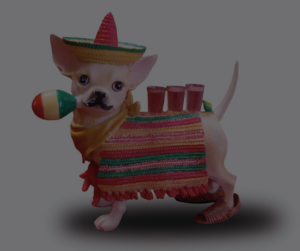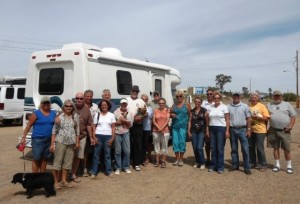
April 10, 2013 – Here we sit at our friends Terry & Lee in Modesto, California reflecting on the last few days of the March tour as we are heading home after another very successful season, hard to believe almost 6 months has gone by already. On Day 29 with left early from Sordo Mudo in the Valley of Guadalupe heading for Tecate and our border crossing, this last group seemed always to be early birds ready to get going. Before you knew it everyone had filled up and we were at the border line up, 45 minutes later we were crossing into the US. This time however they put us through the Truck Crossing Gate, not the RV entrance, not really sure why. We all made it through and assembled back in the US except Jeff & Michelle who were at the end seemed to be taking a very long time. We learned that they were late because they literally got hung up with a gate at the exit on their slide awning, what a mess. Unfortunately no staff at the border gave them any clear direction on how to exit the crossing and they made a tight turn which was the problem. What a mess!
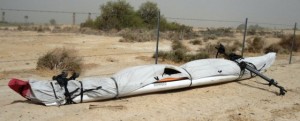
We said our goodbyes, collected the evaluations and radios and headed off to see Mike & Wilmina at the Potrero General Store. Michelle & Jeff followed and we were able to removed the torn and broken awning off their 5th Wheel so they good carry on northward. We had a short tour of the new Bar & Grill that was going to open as part of the General Store building in 2 weeks. Mike & Wilmina have done a great we are sure this will become a very popular destination with locals and tourists alike. Mike gave us a heads up about the wind in the pass and I decided to take Hwy 94 east all the way past Jacumba where we joined I-8 missing all the passes, with the wind behind us I thought all was good, next stop Salton City to stay with friends on our travels home. Our experience has been that the winds normally dissipate substantially as we enter the Imperial Valley and it opens up, not today. We made the turn off the I-8 onto S30 northward from El Centro to Westmorland, now we had cross winds and they were strong. Traffic continued and we slowed down to 40 miles per hour happy we did not have far to go.
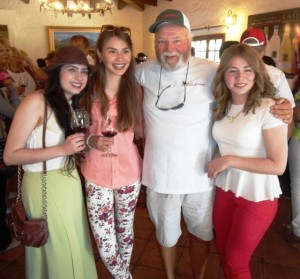
From Westmoreland we turned northwest on Hwy 86 to our destination, normally a 40 minute drive. The wind got stronger, we started to see sand storms coming across the highway that totally obscured our vision and we had to pull off the hwy a couple of times. 20 miles south of Salton City a gust (later we learned it a may have been hurricane force) tore the Kayak, Stand Up Paddleboard and Yakima Racks off the van headed east to Yuma. Without the fence I am sure we would never have seen them again. After I stopped and got out at first glance they Kayak did not look so bad, however the cover was still on it. On inspection it was really messed up, big holes and broken in many spots, after talking with BCAA we took lots of photos and left it where it landed. Remarkably the SUP was in much better shape although the case was trashed the board had been damaged in a few spots, we will see if it can be repaired. A CHP Officer stopped to see if we needed help, he assisted me in putting the SUP in the trailer. Another claim with ICBC should cover the damage to the van, racks and supports equipment, this was a traumatic event we do not want to repeat, the good news is everyone is okay.
We have driven in a lot of wind on Baja, nothing like this ever, I will take narrow road over hurricane force gusts any day!
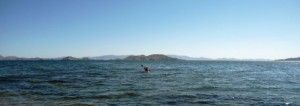
Everyone enjoyed our time in Bahia De Los Angeles, the entrance on the highway is really a stunningly beautiful view we will never tire of. Tony & Ursula had long since left the old government campground and we were the only RVs in the park, lots of spots to choose from, all with a view. The gang had a great visit to the Museum that included some shopping then off to visit Herman Hill, author of “Baja’s Hidden Gold”. Herman was in fine form, at 91 he is still sharp, he had everyone’s attention spinning his yarns about prospecting in Baja and what did those Jesuits do with all that gold? He sold many books, signed them and did some photos, it was all good. Later at our Happy Hour Antonio & Bety Resendiz dropped bye and talked about the work they had done with turtles in Bahia and shared some stories about the history of the village including some notable local events; everyone will remember the dead guy in the freezer and the west wind.
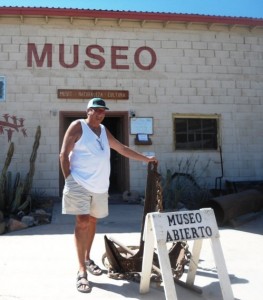
Day 27 and we left LA Bay behind and headed for Vicente Guerrero and the Baja Fiesta Restaurant. This is the longest driving day on the tour however we have lots of stops built into this drive. We left a little earlier then our scheduled departure at 8am arriving about 3:30 pm at our destination. The showers were hot, some loaded up on fresh water and the WiFi was popular. Dinner was great, Ceclia, her son’s Ivan & Abi and staff do an excellent job! For those having steak, these were likely the best on Baja. A number of us came for breakfast at 7am, they opened just for us; this is a real plus for sure.
Day 28 and we are headed for the Valley of Guadalupe and the RV Park at Sordo Mudo, the campground associated with the Christian School for deaf and mute children. Our stop includes a Wine Tour & Tasting at LA Cetto, unfortunately Pedro Domec was closed for renovations, maybe next year? LA Cetto was busy as this was Sunday and the last holiday of the Easter break known as Semana Santa. With Marianna’s help we were able to get Gilberto to take our group on the tour and host the tasting. This was definitely lots of fun! Back at the campground Bill & Marilyn, Baja friends from Tecolote & Rancho Verde arrived and joined our final Happy Hour. Howard from the school also dropped bye and explained to folks what they do and answered some questions about their program.
Overall we had a wonderful season on Baja this year, we met lots of new people and made many new friends, we are glad we could share Baja with all of you.
Thank you, Muchas gracias!
Did you know?
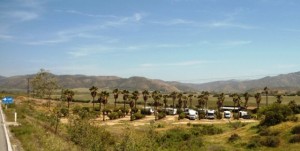
Russians have made a significant contribution to Baja California Mexico in the Valley of Guadalupe. In early 1881, a Czar Nicholas II decree demanded military service and the Molokans (Russian for milk drinkers) resisted due to their beliefs which included pacifism. The government responded with exile, imprisonment, torture, and forceful induction into the armed forces. They decided to try to migrate to the United States and eventually received permission to leave Russia with many moving to California, most settling around Los Angeles. Soon this rural group, however, found a big city environment a little difficult for raising crops and had to look elsewhere.
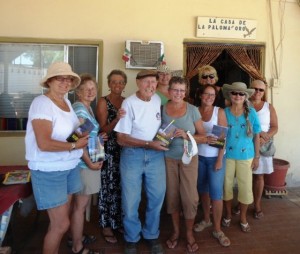
In 1905 as Mexican President Porfirio Diaz agreed to sell the sect 13,000 acres of fertile land in Baja California’s Guadalupe Valley. Hence initially 50 families of Molokans, who had originally settled in Los Angeles after emigrating from Russia, relocated Mexico and they would become the most successful Molokan colony in North America. Eventually 105 families of Russian settlers (about 500 total) laid out their town the way they had at home, equal partitioned lots along a broad tree-covered avenue. Their whitewashed adobe and wood Russian style homes with steep-pitched wooden (some thatched) roofs had front doors that faced away from the street. Other ranchers had already arrived in the valley and the fledgling viniculture of the area had already begun, along with cattle ranching and other farming. They grew a variety of cash crops including wheat, alfalfa, grapes, and tomatoes. They also set about growing olives and raised gaggles of geese and bees for honey.
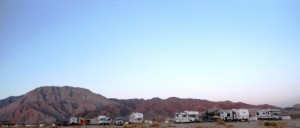
In 1907, Molokans first introduced grapes into the valley on a large scale. The missionaries had planted some small vineyards near the mission prior to 1907, but never really developed the full potential that the valley could offer. Some members of the Russian community had gained experience growing grapes in Europe and put their skills and knowledge to work in creating one of the most important grape producing regions in the world. Several important varieties of table and other grapes were grown such as: Emperor, Ribbier, Thompson (seedless), Flame, Tokay, and White Muscatel.
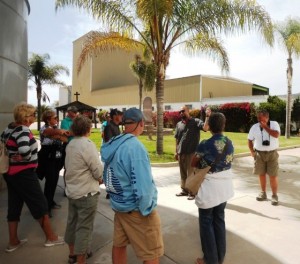
The farming colony grew quickly with over 800 Russians in the valley by 1928 many became Mexican citizens by naturalization or by birth. In 1938 the popular Mexican President Cardenas designated lands for the peasants of Mexico. Guadalupe was engulfed by 3,000 Mexicans and the town was renamed Francisco Zarco. The farming colony grew well until about 1940 when many began to move back into California to join others near the town of Bakersfield. By 1947 there were 49 families remaining in Guadalupe Valley. The farms flourished and the former arid and unproductive land was now converted in a very productive oasis of plenty. Wild horses, descendants of Spanish horses, were tamed and trained as draft horses making the Molokans the first ones in Mexico to use horses instead of oxen to work their farming equipment.
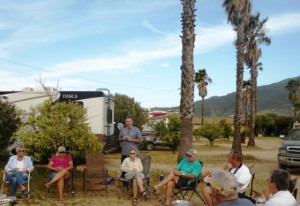
Their village was originally quite isolated, reflecting their desire to withdraw from society, but in 1958, road construction in the area resulted in an influx of Mexican and other settlers; some Molokans again chose to flee encroaching urbanisation, and returned to the United States, others stayed and over time have assimilated into the culture. In 1959 squatters began to invade the valley and took over many Molokan farms forcing the Russians to abandon almost all property and investments by 1965. By the 1990s, only one Molokan family remained in the area.
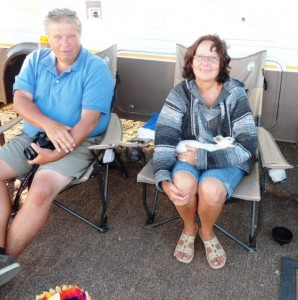
Today a few descendants of the original Molokans families continue to grow grapes and make wine. David and Abel Bibayoff Dalgoff own and cultivate about 80 acres of table and wine grapes in a region of Guadalupe Valley called Rancho Toros Pintos. Alexie M. Dalgoff obtained a permit to make wine in the 1930’s and the family continues the wine growing and winemaking tradition with a nice selection of wines and quality table grapes from their beautiful vineyard.

